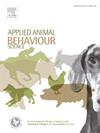Effects of light spectrum on pig behaviour, health and growth
IF 2.2
2区 农林科学
Q1 AGRICULTURE, DAIRY & ANIMAL SCIENCE
引用次数: 0
Abstract
Pigs show preferences to display certain behaviours under specific light spectra. Moreover, adding UVB light to the spectrum might enhance pigs’ vitamin D status. Despite the potential, there are still gaps in understanding the broader effects of light spectrum on pig behaviour, health and growth due to the limited number of studies. Therefore, this study investigated how various light spectra, including exposure to UVB light, influence the behaviour, health and growth of growing-finishing pigs. An experiment with a split-plot design was conducted on a commercial farm, testing four different light spectra in plots (warm white; 2594 K, forest white; 4336 K, cool white; 6235 K, fluorescent tubes; 3787 K), and the addition of UVB light in subplots (UVB or non-UVB). Each light spectrum was tested on 112 pigs divided into two batches of eight pens each. Within each light spectrum, 28 pigs received additional UVB light. Pig behaviour was analysed every two weeks, both manually and using computer vision, while health was assessed weekly. Pigs were weighed at the start of the experiment and before transport to the slaughterhouse. During slaughter, abnormalities on carcasses were scored and blood samples were collected for analysis of vitamin D and bone modelling-related variables. Effects of light spectra on positive and negative social interactions, exploration and play behaviour were inconsistent over time and were mainly found in the first six weeks. Moreover, light spectrum had a varying impact on pig activity, depending on the week. From week 6 onwards, pigs exposed to fluorescent tubes and forest white light spent more time in active postures (i.e. standing and sitting) than other light spectra. However, light spectra had no effect on the distance moved by pigs. Additional UVB light reduced damaging behaviours in week 4 and reduced the severity of ear and lesions on the middle body section throughout the growing-finishing phase. Furthermore, pigs exposed to UVB light had a higher blood vitamin D level than pigs not exposed to UVB light, this had, however, no effect on bone modelling variables. None of the light treatments influenced carcass abnormalities or growth. Overall, results suggest that light spectrum seems to have limited effects on behaviour, health and growth of growing-finishing pigs kept in commercial conditions with limited space and a relatively barren environment. As this is the first study addressing effects of light spectrum on different aspects of pig welfare, further research is needed to corroborate these findings.
光谱对猪行为、健康和生长的影响
猪在特定的光谱下表现出特定的行为偏好。此外,在光谱中加入UVB光可能会提高猪的维生素D水平。尽管有潜力,但由于研究数量有限,在了解光谱对猪行为、健康和生长的更广泛影响方面仍然存在差距。因此,本研究调查了不同光谱,包括暴露于UVB光,如何影响生长育肥猪的行为、健康和生长。在一个商业农场进行了一项分块设计的实验,测试了四种不同的光谱(暖白色;2594 K,森林白色;4336 K,冷白色;6235 K,荧光灯管;3787 K),以及在子图中添加UVB光(UVB或非UVB)。每种光谱对112头猪进行了测试,这些猪被分成两批,每批8个猪圈。在每个光谱范围内,28头猪接受了额外的UVB光。研究人员每两周对猪的行为进行一次分析,包括人工分析和计算机视觉分析,同时每周对猪的健康状况进行评估。猪在实验开始和运往屠宰场之前称重。在屠宰过程中,对尸体的异常情况进行评分,并收集血液样本以分析维生素D和骨骼建模相关变量。随着时间的推移,光谱对积极和消极的社会互动、探索和游戏行为的影响是不一致的,主要发生在前六周。此外,根据不同的周,光谱对猪的活动有不同的影响。从第6周开始,暴露在荧光灯管和森林白光下的猪比其他光谱下的猪在活动姿势(即站立和坐着)上花费的时间更多。然而,光谱对猪的移动距离没有影响。额外的UVB光减少了第4周的破坏行为,并在整个生长-育肥阶段降低了耳朵和身体中部病变的严重程度。此外,暴露在UVB光下的猪的血液维生素D水平高于未暴露在UVB光下的猪,然而,这对骨骼建模变量没有影响。光处理对胴体畸形和生长均无影响。总体而言,研究结果表明,在有限空间和相对贫瘠的商业条件下,光谱对生长肥育猪的行为、健康和生长的影响似乎有限。由于这是第一次研究光谱对猪福利不同方面的影响,需要进一步的研究来证实这些发现。
本文章由计算机程序翻译,如有差异,请以英文原文为准。
求助全文
约1分钟内获得全文
求助全文
来源期刊

Applied Animal Behaviour Science
农林科学-行为科学
CiteScore
4.40
自引率
21.70%
发文量
191
审稿时长
18.1 weeks
期刊介绍:
This journal publishes relevant information on the behaviour of domesticated and utilized animals.
Topics covered include:
-Behaviour of farm, zoo and laboratory animals in relation to animal management and welfare
-Behaviour of companion animals in relation to behavioural problems, for example, in relation to the training of dogs for different purposes, in relation to behavioural problems
-Studies of the behaviour of wild animals when these studies are relevant from an applied perspective, for example in relation to wildlife management, pest management or nature conservation
-Methodological studies within relevant fields
The principal subjects are farm, companion and laboratory animals, including, of course, poultry. The journal also deals with the following animal subjects:
-Those involved in any farming system, e.g. deer, rabbits and fur-bearing animals
-Those in ANY form of confinement, e.g. zoos, safari parks and other forms of display
-Feral animals, and any animal species which impinge on farming operations, e.g. as causes of loss or damage
-Species used for hunting, recreation etc. may also be considered as acceptable subjects in some instances
-Laboratory animals, if the material relates to their behavioural requirements
 求助内容:
求助内容: 应助结果提醒方式:
应助结果提醒方式:


